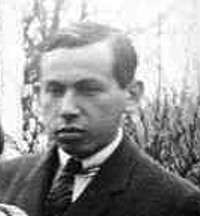Sándor Barta
Sándor Barta (7 October 1897, Budapest – 3 June, 1938) was a Hungarian poet active in various avant-garde movements. After emigrating to the Soviet Union, he remained active amongst German-speaking cultural groups. He was an active agent in carrying out the Stalinist purges amongst the literary intelligentsia, but was himself arrested by the Soviet authorities and shot in 1938.[1]

Early life
His schooling stopped at secondary school and he went to work in his father's workshop. However he suffered from tuberculosis as a teenager. Then he got a job as a bookshop assistant and became involved with the Galileo Circle.[2] He started writing poetry, and his first poem was published in MA. He married the poet Erzsi Újvári the sister of Lajos Kassák who edited MA.[3]:27
In Vienna
MA period
Barta wrote the manifesto "A zöldfejü ember" (The Green Headed Man) appeared in the January 1921 issue of MA in January. This indicates an interest in Dadaism, but Lassák was to later distance himself from Dadaism and Barta claiming that it was only published to appease Barta.[4]
 "A zöldfejü ember" page 1
"A zöldfejü ember" page 1 "A zöldfejü ember" page 2
"A zöldfejü ember" page 2
Akasztott Ember
Barta launched the journal Akasztott Ember ("Hanged Man") in November 1922. In 1923 it was renamed Ék ("Wedge").[5] He explained the title thus: "As people, we now feel ourselves to be hanged. And if someone doesn't feel hanged, he belongs among those who hang and kick us".[6]
References
- Forgács, Éva; Miller, Tyrus (2013). ""The Avant-Garde in Budapest and in Exile in Vienna: A Tett (1915-6), Ma (Budapest 1916-9; Vienna 1920-6), Egység (1922-4), Akasztott Ember (1922), 2x2 (1922), Ék (1923-4), Is (1924), 365 (1925), Dokumentum (1926-7), and Munka (1928-39)"" (PDF). Modernist Magazines. III (Part II): 1128-1156. Retrieved 25 September 2019.
- "Magyar Életrajzi Lexikon 1000-1990". mek.oszk.hu. Hungarian Electronic Library. Retrieved 28 November 2018.
- Cornis-Pope, Marcel; Neubauer, John (2007). History of the Literary Cultures of East-Central Europe: Junctures and disjunctures in the 19th and 20th centuries. Volume III: The making and remaking of literary institutions. Amsterdam/Philadelphia: John Benjamins Publishing. ISBN 9789027292353.
- Mazzone, Marian (2004). "Dadaist Text/Constructivist Image: Kassák's Képarchitektúra". Hungarian Studies Review. XXXI (1–2): 15–46. Retrieved 29 November 2018.
- Cardullo, Bert (2013). Theories of the Avant-garde Theatre: A Casebook from Kleist to Camus. Rowman & Littlefield. ISBN 9780810887046.
- Botar, Oliver A. I. (1993). "From the Avant-Garde to "Proletarian Art" The Emigre Hungarian Journals Egyseg and Akasztott Ember, 1922-23" (PDF). 52. Retrieved 26 June 2018. Cite journal requires
|journal=(help)